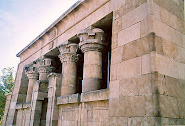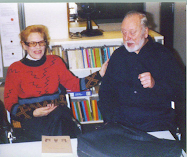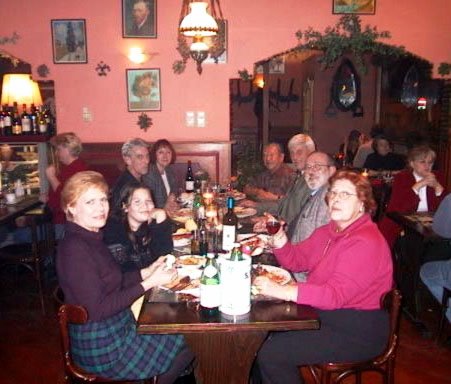 From Barbara Walker's "The Woman's Encyclopedia of Myths and Secrets." (Image: 12th century CE, Byzantine representation of Inanna, the Tree of Life -- a date palm)
Palm Tree
In the Babylonian myth of the primal garden, the palm tree was the Tree of Life, a dwelling-place of the Goddess Astarte. The Hebrew version of her name was Tamar, "Palm Tree."(1)
Her male counterpart was Baal-Peor, or Phoenix, the god of Phoenicia whose name meant "Land of the Palm." As a phallic deity, Baal-Peor was symbolized by a palm tree between two large stones. Sexual orgies in the temple celebrated his union with the Goddess in Phoenicia and in Israel until priests of Yahweh killed the celebrants in the midst of their rites (Numbers 25:8):
[Here's the story in the Bible, from the "Living Bible" translation: Numbers 25:1: While Israel was camped at Acacia, some of the young men began going to wild parties with the local Moabite girls. (2) These girls also invited them to attend the sacrifices to their gods, and soon the men were not only attending the feasts, but also bowing down and worshipping the idols. (3) Before long, all Israel was joining freely in the worship of Baal, the god of Moab; and the anger of the Lord was hot against his people. (4) He issued the following command to Moses:
"Execute all the tribal leaders of Israel. Hang them up before the Lord in braod daylight, so that his fierce anger will turn away from the people." {such a kind, loving god, ahem...}
5) So Moses ordered the judges to execute all who had worshipped Baal. {If ALL of Israel was joining freely in the worship of Baal, who would be left to continue the nation of Israel after Moses had them all killed??? - What is being talked about here is the MEN of Israel, that is, dudes old enough to copulate.}
(6) But one of the Israeli men insolently brought a Midianite girl into the camp, right before the eyes of Moses and all of the people, as they were weeping before the door of the Tabernacle. (7) When Phineas (son of Eleazor and grandson of Aaron the priest) saw this, he jumped up, grabbed a spear, (8) and rushed after the man into his tent, where he had taken the girl. He thrust the spear all the way through the man's body and into her stomach. So the plague was stopped, (9) but only after 24,000 people had already died. {Okay, so after ordering Moses to have his priests kill the Israelites because they had ALL SINNED, Yahweh changes his mind - without telling Moses - and decides to kill the Israelites more slowly, with a plague, and they were gathered around the Tabernacle praying for their lives as Yahweh was no doubt sitting on his throne up on Jupiter or wherever laughing his butt off; and then one Israelite dude decides to bring a girl into camp to screw in his tent, right under the eyes of everyone??? Yeah, right. If they were that stupid, it was better their genes were killed than passed on to children!
From Barbara Walker's "The Woman's Encyclopedia of Myths and Secrets." (Image: 12th century CE, Byzantine representation of Inanna, the Tree of Life -- a date palm)
Palm Tree
In the Babylonian myth of the primal garden, the palm tree was the Tree of Life, a dwelling-place of the Goddess Astarte. The Hebrew version of her name was Tamar, "Palm Tree."(1)
Her male counterpart was Baal-Peor, or Phoenix, the god of Phoenicia whose name meant "Land of the Palm." As a phallic deity, Baal-Peor was symbolized by a palm tree between two large stones. Sexual orgies in the temple celebrated his union with the Goddess in Phoenicia and in Israel until priests of Yahweh killed the celebrants in the midst of their rites (Numbers 25:8):
[Here's the story in the Bible, from the "Living Bible" translation: Numbers 25:1: While Israel was camped at Acacia, some of the young men began going to wild parties with the local Moabite girls. (2) These girls also invited them to attend the sacrifices to their gods, and soon the men were not only attending the feasts, but also bowing down and worshipping the idols. (3) Before long, all Israel was joining freely in the worship of Baal, the god of Moab; and the anger of the Lord was hot against his people. (4) He issued the following command to Moses:
"Execute all the tribal leaders of Israel. Hang them up before the Lord in braod daylight, so that his fierce anger will turn away from the people." {such a kind, loving god, ahem...}
5) So Moses ordered the judges to execute all who had worshipped Baal. {If ALL of Israel was joining freely in the worship of Baal, who would be left to continue the nation of Israel after Moses had them all killed??? - What is being talked about here is the MEN of Israel, that is, dudes old enough to copulate.}
(6) But one of the Israeli men insolently brought a Midianite girl into the camp, right before the eyes of Moses and all of the people, as they were weeping before the door of the Tabernacle. (7) When Phineas (son of Eleazor and grandson of Aaron the priest) saw this, he jumped up, grabbed a spear, (8) and rushed after the man into his tent, where he had taken the girl. He thrust the spear all the way through the man's body and into her stomach. So the plague was stopped, (9) but only after 24,000 people had already died. {Okay, so after ordering Moses to have his priests kill the Israelites because they had ALL SINNED, Yahweh changes his mind - without telling Moses - and decides to kill the Israelites more slowly, with a plague, and they were gathered around the Tabernacle praying for their lives as Yahweh was no doubt sitting on his throne up on Jupiter or wherever laughing his butt off; and then one Israelite dude decides to bring a girl into camp to screw in his tent, right under the eyes of everyone??? Yeah, right. If they were that stupid, it was better their genes were killed than passed on to children! What I want to know is why the priests did not carry out Yahweh's orders to kill ALL of Israel immediately after the order was issued? Did their arms get tired? And is Moabite the same as Midianite? Moses MARRIED a Midianite woman himself!}
(10, 11) Then the Lord said to Moses, "Phineas (son of Eleazar and grandson of Aaron the priest) {I guess the Lord had to let Moses know just who the good guy was in case Moses didn't understand which Phineas killed the bad guy and his gal} has turned away my anger for he was angry with my anger, and would not tolerate the worship of any God but me. So I have stopped destroying all Israel as I had intended. (12, 13) Now because of what he has done - because of his zeal for his God, and because he has made atonement for the people of Israel for what he did - I promise that he and his priests shall be priests forever."
(14) The name of the man who was killed with the Midianite girl was Zimri, son of Salu, a leader of the tribe of Simeon. (15) The girl's name was Corbi, daughter of Zur, a Midianite prince. (Emphasis added).
[Summary: Yahweh got his BLOOD SACRIFICE of both an Israelite prince and a Midianite princess, and thus his blood lust was temporarily satisfied. This is classic substitute king sacrifice, in this case, the "king" being Moses, who was raised in the Egyptian rites. Being a relatively new Hebrew religion, the priests added the "bad girl" into the blood sacrifice because she represented a much older tradition of the Temptress Goddess, which was a great threat to the upstart god Yahweh's authority, and therefore she had to be diminished in some way. What better way than to kill her off with a "spear" (phallic symbol) through her "stomach" (a euphenism for her female parts) while she was copulating with the sacrificial male victim, who himself was a substitute for the very same god that ordered his death?]
Still, the feminine connotations of the palm tree remained. The Goddess was often embodied in a Mother-palm, giving the food of life in the form of coconut milk or dates. A complicated biblical myth shows Tamar the Palm-tree as the mother of a slain "firstborn of Judah;" and as a veiled sacred harlot decorated with the signet, staff, and bracelets of the nation of Judah; and as a widow (Crone) to whom offerings of goats were made; and as an idol "by the wayside," whom priests of Yahweh wanted to burn (Genesis 38). She gave birth to the rival twins Pharez and Zarah, Hebrew counterparts of Osiris and Set. The spirit of the palm tree was still the Great Mother in the tradition of early Christians, who gave the title of Holy Palm (Ta-Mari) to the virgin Mary.(2) Yet Egyptians continued to call a man's penis his "palm tree."(3)
Notes:
(1) Graves, W.G., 197.
(2) Hughes, 55.
(3) Book of the Dead, 518.
Compare Ta-Mari to this Walker entry on Ta-Mera:
"Land of Waters," an old name of Egypt. Mera or Mara was an archaic name for the Goddess of the primordial sea [thus, for instance, all those "Mares" {"sea of"} names on the face of the Moon and Mars - named by male scientists, by the way, lol!] In Egypt she was even coupled with the sun god as an androgynous deity, Meri-Ra. Among the meanings of Mera were such female symbols as a water-course, ditch, pit, sea, and lovingness.(1)
Notes:
(1) Budge, E.I., 76.
**********************************************************************
Just why is it that female horses are called MARES, and in xiang qi (Chinese chess) the horse is called "ma?" It couldn't have anything to do with "sea horses," could it? And I'm not talking about those cute little critters one keeps in an aquarium. Staunton's model for his knight was reputedly the horses of the Elgin Marbles stolen from the Greek Parthenon. But we all know where the Greeks got their inspiration from...





































No comments:
Post a Comment